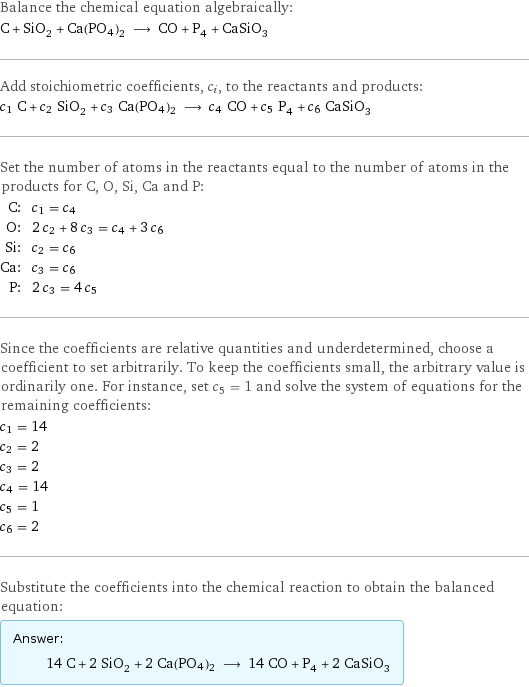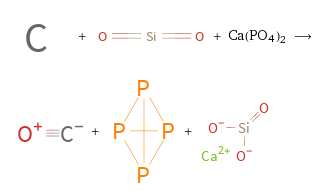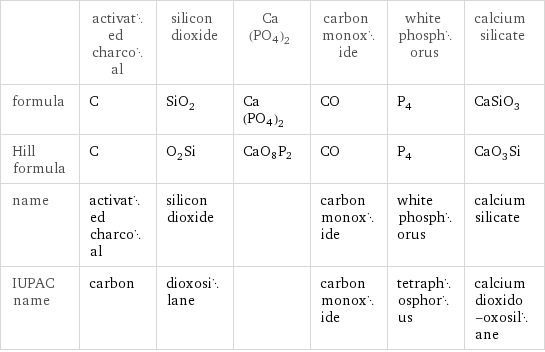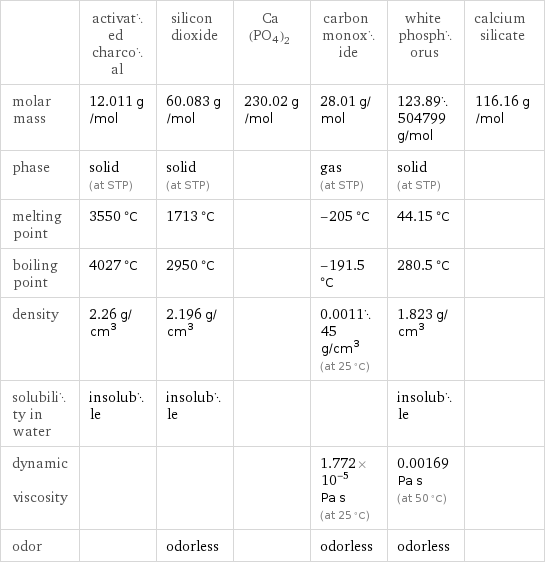Input interpretation

C activated charcoal + SiO_2 silicon dioxide + Ca(PO4)2 ⟶ CO carbon monoxide + P_4 white phosphorus + CaSiO_3 calcium silicate
Balanced equation

Balance the chemical equation algebraically: C + SiO_2 + Ca(PO4)2 ⟶ CO + P_4 + CaSiO_3 Add stoichiometric coefficients, c_i, to the reactants and products: c_1 C + c_2 SiO_2 + c_3 Ca(PO4)2 ⟶ c_4 CO + c_5 P_4 + c_6 CaSiO_3 Set the number of atoms in the reactants equal to the number of atoms in the products for C, O, Si, Ca and P: C: | c_1 = c_4 O: | 2 c_2 + 8 c_3 = c_4 + 3 c_6 Si: | c_2 = c_6 Ca: | c_3 = c_6 P: | 2 c_3 = 4 c_5 Since the coefficients are relative quantities and underdetermined, choose a coefficient to set arbitrarily. To keep the coefficients small, the arbitrary value is ordinarily one. For instance, set c_5 = 1 and solve the system of equations for the remaining coefficients: c_1 = 14 c_2 = 2 c_3 = 2 c_4 = 14 c_5 = 1 c_6 = 2 Substitute the coefficients into the chemical reaction to obtain the balanced equation: Answer: | | 14 C + 2 SiO_2 + 2 Ca(PO4)2 ⟶ 14 CO + P_4 + 2 CaSiO_3
Structures

+ + Ca(PO4)2 ⟶ + +
Names

activated charcoal + silicon dioxide + Ca(PO4)2 ⟶ carbon monoxide + white phosphorus + calcium silicate
Equilibrium constant
![Construct the equilibrium constant, K, expression for: C + SiO_2 + Ca(PO4)2 ⟶ CO + P_4 + CaSiO_3 Plan: • Balance the chemical equation. • Determine the stoichiometric numbers. • Assemble the activity expression for each chemical species. • Use the activity expressions to build the equilibrium constant expression. Write the balanced chemical equation: 14 C + 2 SiO_2 + 2 Ca(PO4)2 ⟶ 14 CO + P_4 + 2 CaSiO_3 Assign stoichiometric numbers, ν_i, using the stoichiometric coefficients, c_i, from the balanced chemical equation in the following manner: ν_i = -c_i for reactants and ν_i = c_i for products: chemical species | c_i | ν_i C | 14 | -14 SiO_2 | 2 | -2 Ca(PO4)2 | 2 | -2 CO | 14 | 14 P_4 | 1 | 1 CaSiO_3 | 2 | 2 Assemble the activity expressions accounting for the state of matter and ν_i: chemical species | c_i | ν_i | activity expression C | 14 | -14 | ([C])^(-14) SiO_2 | 2 | -2 | ([SiO2])^(-2) Ca(PO4)2 | 2 | -2 | ([Ca(PO4)2])^(-2) CO | 14 | 14 | ([CO])^14 P_4 | 1 | 1 | [P4] CaSiO_3 | 2 | 2 | ([CaSiO3])^2 The equilibrium constant symbol in the concentration basis is: K_c Mulitply the activity expressions to arrive at the K_c expression: Answer: | | K_c = ([C])^(-14) ([SiO2])^(-2) ([Ca(PO4)2])^(-2) ([CO])^14 [P4] ([CaSiO3])^2 = (([CO])^14 [P4] ([CaSiO3])^2)/(([C])^14 ([SiO2])^2 ([Ca(PO4)2])^2)](../image_source/18e3c7f2380410622ef3d35fcfd4b0aa.png)
Construct the equilibrium constant, K, expression for: C + SiO_2 + Ca(PO4)2 ⟶ CO + P_4 + CaSiO_3 Plan: • Balance the chemical equation. • Determine the stoichiometric numbers. • Assemble the activity expression for each chemical species. • Use the activity expressions to build the equilibrium constant expression. Write the balanced chemical equation: 14 C + 2 SiO_2 + 2 Ca(PO4)2 ⟶ 14 CO + P_4 + 2 CaSiO_3 Assign stoichiometric numbers, ν_i, using the stoichiometric coefficients, c_i, from the balanced chemical equation in the following manner: ν_i = -c_i for reactants and ν_i = c_i for products: chemical species | c_i | ν_i C | 14 | -14 SiO_2 | 2 | -2 Ca(PO4)2 | 2 | -2 CO | 14 | 14 P_4 | 1 | 1 CaSiO_3 | 2 | 2 Assemble the activity expressions accounting for the state of matter and ν_i: chemical species | c_i | ν_i | activity expression C | 14 | -14 | ([C])^(-14) SiO_2 | 2 | -2 | ([SiO2])^(-2) Ca(PO4)2 | 2 | -2 | ([Ca(PO4)2])^(-2) CO | 14 | 14 | ([CO])^14 P_4 | 1 | 1 | [P4] CaSiO_3 | 2 | 2 | ([CaSiO3])^2 The equilibrium constant symbol in the concentration basis is: K_c Mulitply the activity expressions to arrive at the K_c expression: Answer: | | K_c = ([C])^(-14) ([SiO2])^(-2) ([Ca(PO4)2])^(-2) ([CO])^14 [P4] ([CaSiO3])^2 = (([CO])^14 [P4] ([CaSiO3])^2)/(([C])^14 ([SiO2])^2 ([Ca(PO4)2])^2)
Rate of reaction
![Construct the rate of reaction expression for: C + SiO_2 + Ca(PO4)2 ⟶ CO + P_4 + CaSiO_3 Plan: • Balance the chemical equation. • Determine the stoichiometric numbers. • Assemble the rate term for each chemical species. • Write the rate of reaction expression. Write the balanced chemical equation: 14 C + 2 SiO_2 + 2 Ca(PO4)2 ⟶ 14 CO + P_4 + 2 CaSiO_3 Assign stoichiometric numbers, ν_i, using the stoichiometric coefficients, c_i, from the balanced chemical equation in the following manner: ν_i = -c_i for reactants and ν_i = c_i for products: chemical species | c_i | ν_i C | 14 | -14 SiO_2 | 2 | -2 Ca(PO4)2 | 2 | -2 CO | 14 | 14 P_4 | 1 | 1 CaSiO_3 | 2 | 2 The rate term for each chemical species, B_i, is 1/ν_i(Δ[B_i])/(Δt) where [B_i] is the amount concentration and t is time: chemical species | c_i | ν_i | rate term C | 14 | -14 | -1/14 (Δ[C])/(Δt) SiO_2 | 2 | -2 | -1/2 (Δ[SiO2])/(Δt) Ca(PO4)2 | 2 | -2 | -1/2 (Δ[Ca(PO4)2])/(Δt) CO | 14 | 14 | 1/14 (Δ[CO])/(Δt) P_4 | 1 | 1 | (Δ[P4])/(Δt) CaSiO_3 | 2 | 2 | 1/2 (Δ[CaSiO3])/(Δt) (for infinitesimal rate of change, replace Δ with d) Set the rate terms equal to each other to arrive at the rate expression: Answer: | | rate = -1/14 (Δ[C])/(Δt) = -1/2 (Δ[SiO2])/(Δt) = -1/2 (Δ[Ca(PO4)2])/(Δt) = 1/14 (Δ[CO])/(Δt) = (Δ[P4])/(Δt) = 1/2 (Δ[CaSiO3])/(Δt) (assuming constant volume and no accumulation of intermediates or side products)](../image_source/56e32bbfddb469ee812f37c132dbbdb6.png)
Construct the rate of reaction expression for: C + SiO_2 + Ca(PO4)2 ⟶ CO + P_4 + CaSiO_3 Plan: • Balance the chemical equation. • Determine the stoichiometric numbers. • Assemble the rate term for each chemical species. • Write the rate of reaction expression. Write the balanced chemical equation: 14 C + 2 SiO_2 + 2 Ca(PO4)2 ⟶ 14 CO + P_4 + 2 CaSiO_3 Assign stoichiometric numbers, ν_i, using the stoichiometric coefficients, c_i, from the balanced chemical equation in the following manner: ν_i = -c_i for reactants and ν_i = c_i for products: chemical species | c_i | ν_i C | 14 | -14 SiO_2 | 2 | -2 Ca(PO4)2 | 2 | -2 CO | 14 | 14 P_4 | 1 | 1 CaSiO_3 | 2 | 2 The rate term for each chemical species, B_i, is 1/ν_i(Δ[B_i])/(Δt) where [B_i] is the amount concentration and t is time: chemical species | c_i | ν_i | rate term C | 14 | -14 | -1/14 (Δ[C])/(Δt) SiO_2 | 2 | -2 | -1/2 (Δ[SiO2])/(Δt) Ca(PO4)2 | 2 | -2 | -1/2 (Δ[Ca(PO4)2])/(Δt) CO | 14 | 14 | 1/14 (Δ[CO])/(Δt) P_4 | 1 | 1 | (Δ[P4])/(Δt) CaSiO_3 | 2 | 2 | 1/2 (Δ[CaSiO3])/(Δt) (for infinitesimal rate of change, replace Δ with d) Set the rate terms equal to each other to arrive at the rate expression: Answer: | | rate = -1/14 (Δ[C])/(Δt) = -1/2 (Δ[SiO2])/(Δt) = -1/2 (Δ[Ca(PO4)2])/(Δt) = 1/14 (Δ[CO])/(Δt) = (Δ[P4])/(Δt) = 1/2 (Δ[CaSiO3])/(Δt) (assuming constant volume and no accumulation of intermediates or side products)
Chemical names and formulas

| activated charcoal | silicon dioxide | Ca(PO4)2 | carbon monoxide | white phosphorus | calcium silicate formula | C | SiO_2 | Ca(PO4)2 | CO | P_4 | CaSiO_3 Hill formula | C | O_2Si | CaO8P2 | CO | P_4 | CaO_3Si name | activated charcoal | silicon dioxide | | carbon monoxide | white phosphorus | calcium silicate IUPAC name | carbon | dioxosilane | | carbon monoxide | tetraphosphorus | calcium dioxido-oxosilane
Substance properties

| activated charcoal | silicon dioxide | Ca(PO4)2 | carbon monoxide | white phosphorus | calcium silicate molar mass | 12.011 g/mol | 60.083 g/mol | 230.02 g/mol | 28.01 g/mol | 123.89504799 g/mol | 116.16 g/mol phase | solid (at STP) | solid (at STP) | | gas (at STP) | solid (at STP) | melting point | 3550 °C | 1713 °C | | -205 °C | 44.15 °C | boiling point | 4027 °C | 2950 °C | | -191.5 °C | 280.5 °C | density | 2.26 g/cm^3 | 2.196 g/cm^3 | | 0.001145 g/cm^3 (at 25 °C) | 1.823 g/cm^3 | solubility in water | insoluble | insoluble | | | insoluble | dynamic viscosity | | | | 1.772×10^-5 Pa s (at 25 °C) | 0.00169 Pa s (at 50 °C) | odor | | odorless | | odorless | odorless |
Units
